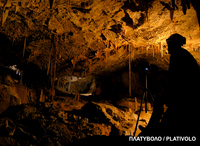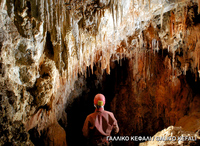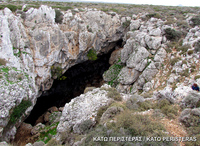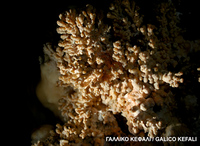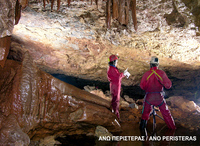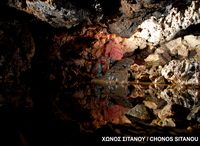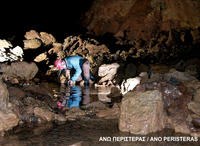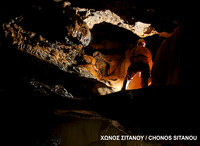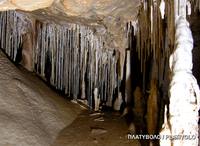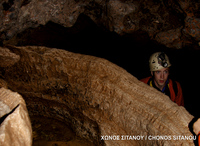Speleological Park of Sitia-Itanos
The mountainous areas of Sitia, in comparison with other mountainous areas of Crete, do not have intense formations. However, due to the limestone composition of its rocks, the rain and river water has created an extended surface carst. In some places, the carst is quite impressive and has formed hundreds of limestone tips that look like a meteorite rain with uneven shapes. Even more impressive from the surface carst is the underground carst. There is a small amount of running water on the surface, as most of it is absorbed in the subsoil and moves underground through the multiple channels of the water-soluble limestone. In the mountainous area of Itanos only, more than 82 caves, chasms, sinks and underground rivers have been recorded and the total explored routes are more than 6,000 meters and basically provide a bilge system for the province. From here, the waters flow to the east to finally end up in various springs near the east coastline, like the ones in Zakros and Hohlakia. The past few years, the municipality of Itanos in cooperation with the speleological Club of Crete are working towards the creation of a speleological park. Many of the caves of Sitia, and of Crete in general, are connected with religious rituals and traditions dating back to the Minoan period. For the time being, the caves are not open to the public. However, it is possible to access some of them with the appropriate equipement. The most important caves of the region that functioned as sites of worship in the past are:
The cave Okso Latsidi
The cave Okso Latsidi is located in the area of the village Sitanos and it is part of an extended cave complex that expands for more than 6,000 meters in the subsoil of mountainous Sitia. It is one of the richest carst formations in Crete. Its entrance is next to the provincial road of Sitia-Karydi, between the villages of Sitanos and Katsidoni in an altitude of 684 meters. The main entrance (there are two) has a diameter of 2 meters and has an intense downwards inclination, which exlpains its name ("Latsidi" means "hole" in Eastern Crete). Right after the entrance, a large chamber is revealed, again with a downwards inclination. Its ground is covered with stones of many sizes, clay, and other material, such as wood, branches and leaves. After passing this chamber, and for the next 250 meters, there are five large, uneven chambers, which are connected with small passages. After passing the sixth chamber there are small tunnels that periodically become narrow. Water flows in their pavement, which increases during the rain seasons. It is believed that the cave of Okso Latsidi used to be part of an underground river.
The cave of Peristeras
Another important cave of the province is the cave of Peristeras. It is located 2km east from the village Karydi, in the area of Platyvolas, in an altitude of 540 meters. It has a rich rock decoration and 170 meters of explored routes. Here too, signs of human presence were discovered, dating back to the Neolithic period.
The cave of Pelekiton
It is also called "tis sukias o Spilios" (meaning, the cave of the fig tree), as there is a fig tree in the entrance. Its official name, however, is connected to the wider region, where there were stone mines. It is located northeast from Kato Zakros, in an altitude of 100 meters and it is about 310 meters long. Its entrance is impressive with a chamber of downwards inclination. This cave is not only beautiful, as it has a rich adornment, it is also one of the greatest archeological caves of the region, as signs of human presence are found, dating back to the Neolithic period.
Vreiko
This cave is located 5km away from the village Pefkoi. The road ends in about 500 meters from the cave's entrance, but it is accessible by walking. Signs of human presence have been discovered, dating back to the Neolithic period.
Megalo Katofygi
In the north of the village Tourtouloi or Aghios Georgios, one can find the cave of Megalo Katofygi, one of the most important caves of eastern Crete. It is located in an altitude of 450 meters and its entrance leads us to a chamber complex with an excellent adornment of stalagmites and stalactites
The cave of Petsofa (Itanos)
In an altitude of 80 meters, about 500 meters northwest from the area of Rousolakkos, there is the visible opening of the cave of Petsofa, which was named after the hill. It is a very small cave (about 3x5m) with a large archeological importance, as here many broken amphoras as well as a number of inscriptions have been found.
(*Note: the information on gorges, caves and the hiking trails E4 of the Sitia region are general. The visitor is responsible in every case to evaluate his/her personal abilities and knowledge in order to choose the appropriate way to enjoy the proposed routes and sights)






